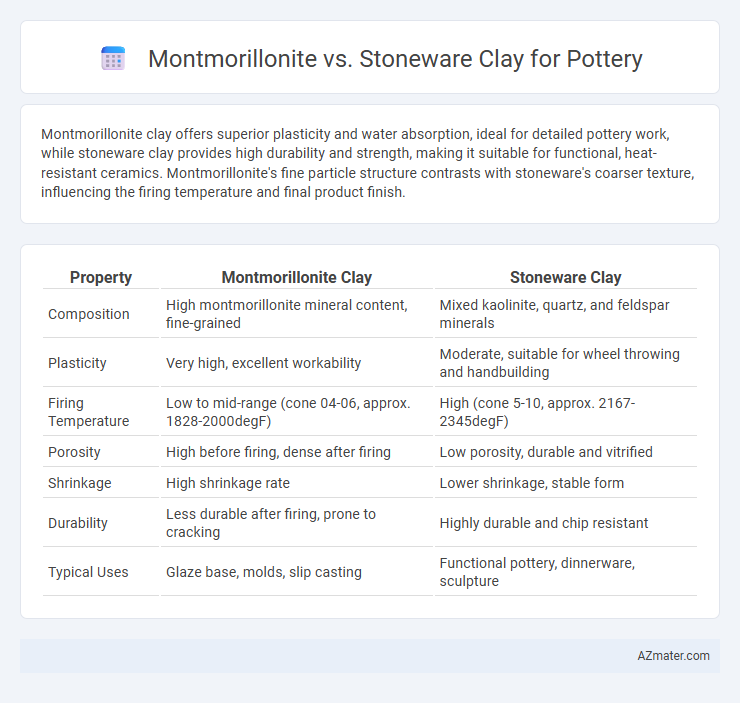Montmorillonite clay offers superior plasticity and water absorption, ideal for detailed pottery work, while stoneware clay provides high durability and strength, making it suitable for functional, heat-resistant ceramics. Montmorillonite's fine particle structure contrasts with stoneware's coarser texture, influencing the firing temperature and final product finish.
Table of Comparison
| Property | Montmorillonite Clay | Stoneware Clay |
|---|---|---|
| Composition | High montmorillonite mineral content, fine-grained | Mixed kaolinite, quartz, and feldspar minerals |
| Plasticity | Very high, excellent workability | Moderate, suitable for wheel throwing and handbuilding |
| Firing Temperature | Low to mid-range (cone 04-06, approx. 1828-2000degF) | High (cone 5-10, approx. 2167-2345degF) |
| Porosity | High before firing, dense after firing | Low porosity, durable and vitrified |
| Shrinkage | High shrinkage rate | Lower shrinkage, stable form |
| Durability | Less durable after firing, prone to cracking | Highly durable and chip resistant |
| Typical Uses | Glaze base, molds, slip casting | Functional pottery, dinnerware, sculpture |
Understanding Montmorillonite Clay
Montmorillonite clay, characterized by its high swelling capacity and fine particle size, offers exceptional plasticity and adsorption properties ideal for intricate pottery work, unlike stoneware clay which is denser and more refractory. This smectite clay's unique ability to absorb water enhances its plasticity, making it easier to shape delicate forms and retain moisture during drying. In contrast, stoneware clay, composed mainly of feldspar, quartz, and kaolinite, provides durability and strength but lacks the same level of malleability and absorption found in montmorillonite.
Overview of Stoneware Clay
Stoneware clay is a durable, non-porous ceramic material fired at high temperatures between 1,200degC and 1,300degC (2,192degF to 2,372degF), making it ideal for functional pottery such as dinnerware and cookware. Compared to Montmorillonite, which is a highly plastic and fine-grained clay primarily used as an additive to improve workability, stoneware clay offers superior strength and thermal resistance due to its natural composition of silica, alumina, and fluxes. Its dense structure and vitrification during firing result in robust, chip-resistant pottery that withstands daily use and exposure to water without needing additional glazing.
Key Mineral Composition Differences
Montmorillonite clay primarily consists of smectite group minerals, characterized by their high swelling capacity and layered silicate structures rich in aluminum and magnesium. Stoneware clay contains a blend of kaolinite, quartz, and mica with higher kaolinite content, resulting in lower plasticity but greater durability after firing. These mineralogical differences influence water absorption, plasticity, and firing temperature, making montmorillonite ideal for fine, detailed pottery and stoneware preferred for sturdy, high-fired ceramic goods.
Plasticity and Workability Compared
Montmorillonite clay exhibits exceptionally high plasticity due to its fine particle size and swelling properties, making it ideal for intricate pottery work requiring smooth shaping and molding. Stoneware clay, while less plastic than montmorillonite, offers moderate workability with better structural strength and reduced shrinkage during firing, suited for durable, functional pottery pieces. The choice between montmorillonite and stoneware clay depends on the desired balance between ease of manipulation and final product resilience.
Firing Temperatures and Behaviors
Montmorillonite clay typically fires at lower temperatures, around cone 04 to cone 06 (1,060degC to 1,123degC), exhibiting high plasticity and excellent water absorption, making it suitable for low-fire, delicate pottery. Stoneware clay requires higher firing temperatures, generally between cone 6 and cone 10 (1,220degC to 1,300degC), resulting in a denser, more vitrified body with increased durability and chip resistance. The thermal behavior of Montmorillonite allows for more porous and lightweight pieces, whereas Stoneware undergoes significant vitrification, creating stone-like hardness ideal for functional pottery.
Durability and Functional Properties
Montmorillonite clay exhibits high plasticity and excellent water absorption, making it suitable for intricate pottery designs, but it tends to shrink significantly during drying and firing, which can impact durability. Stoneware clay offers superior strength and durability due to its dense, vitrified structure after firing at high temperatures, resulting in less porosity and increased resistance to chipping and thermal shock. The choice between Montmorillonite and Stoneware clay depends on the balance between desired detail work and functional strength, with Stoneware generally preferred for durable, functional pottery.
Aesthetic Qualities and Glazing Results
Montmorillonite clay offers superior plasticity and a smooth, fine texture that enhances detailed pottery work and allows for vibrant, consistent glazing results with a glass-like finish. Stoneware clay features a coarser texture and higher iron content, producing earthy, rustic aesthetics with muted glaze tones and increased durability after firing. The choice between these clays significantly affects the final appearance and glaze adherence, with Montmorillonite favoring delicate, polished surfaces and Stoneware supporting robust, traditional finishes.
Suitability for Different Pottery Techniques
Montmorillonite clay, characterized by its high plasticity and fine particle size, is especially suitable for hand-building and intricate sculptural pottery techniques due to its excellent workability and moisture retention. Stoneware clay, known for its durability and coarse texture, excels in wheel-throwing and functional pottery, providing strength and resistance to thermal shock after firing at high temperatures. Choosing between Montmorillonite and Stoneware depends on technique requirements, with Montmorillonite favoring delicate forms and Stoneware suited for robust, utilitarian pieces.
Cost and Availability Considerations
Montmorillonite clay is often more affordable and widely accessible due to its natural abundance and frequent use in industrial applications, making it a cost-effective choice for pottery production. Stoneware clay, while typically more expensive, offers greater durability and is commonly sourced from specialized suppliers, which can limit availability in some regions. Pottery artists must weigh the lower cost and easy procurement of montmorillonite against the superior strength and finish of stoneware when selecting clay for their projects.
Choosing the Right Clay for Your Pottery Project
Montmorillonite clay offers exceptional plasticity and workability, making it ideal for intricate pottery designs and detailed sculpting. Stoneware clay, known for its durability and high firing temperature, provides a strong, stone-like finish perfect for functional ware. Selecting the right clay depends on the desired aesthetic, firing method, and end-use of the pottery piece.

Infographic: Montmorillonite vs Stoneware clay for Pottery
 azmater.com
azmater.com